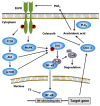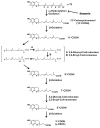Synergistic Anticancer Effect of Tocotrienol Combined with Chemotherapeutic Agents or Dietary Components: A Review
- PMID: 27669218
- PMCID: PMC5085638
- DOI: 10.3390/ijms17101605
Synergistic Anticancer Effect of Tocotrienol Combined with Chemotherapeutic Agents or Dietary Components: A Review
Abstract
Tocotrienol (T3), unsaturated vitamin E, is gaining a lot of attention owing to its potent anticancer effect, since its efficacy is much greater than that of tocopherol (Toc). Various factors are known to be involved in such antitumor action, including cell cycle arrest, apoptosis induction, antiangiogenesis, anti-metastasis, nuclear factor-κB suppression, and telomerase inhibition. Owing to a difference in the affinity of T3 and Toc for the α-tocopherol transfer protein, the bioavailability of orally ingested T3 is lower than that of Toc. Furthermore, cellular uptake of T3 is interrupted by coadministration of α-Toc in vitro and in vivo. Based on this, several studies are in progress to screen for molecules that can synergize with T3 in order to augment its potency. Combinations of T3 with chemotherapeutic drugs (e.g., statins, celecoxib, and gefitinib) or dietary components (e.g., polyphenols, sesamin, and ferulic acid) exhibit synergistic actions on cancer cell growth and signaling pathways. In this review, we summarize the current status of synergistic effects of T3 and an array of agents on cancer cells, and discuss their molecular mechanisms of action. These combination strategies would encourage further investigation and application in cancer prevention and therapy.
Keywords: cancer; synergy; tocotrienol; vitamin E.
Conflict of interest statement
The authors declare no conflict of interest.
Figures





Similar articles
-
Antiangiogenic and anticancer potential of unsaturated vitamin E (tocotrienol).J Nutr Biochem. 2009 Feb;20(2):79-86. doi: 10.1016/j.jnutbio.2008.09.003. Epub 2008 Dec 13. J Nutr Biochem. 2009. PMID: 19071006 Review.
-
Sesamin synergistically potentiates the anticancer effects of γ-tocotrienol in mammary cancer cell lines.Fitoterapia. 2013 Jan;84:347-59. doi: 10.1016/j.fitote.2012.12.013. Epub 2012 Dec 22. Fitoterapia. 2013. PMID: 23266736
-
Tocotrienol as a potential anticancer agent.Carcinogenesis. 2012 Feb;33(2):233-9. doi: 10.1093/carcin/bgr261. Epub 2011 Nov 17. Carcinogenesis. 2012. PMID: 22095072 Review.
-
Anticancer properties of tocotrienols: A review of cellular mechanisms and molecular targets.J Cell Physiol. 2019 Feb;234(2):1147-1164. doi: 10.1002/jcp.27075. Epub 2018 Aug 1. J Cell Physiol. 2019. PMID: 30066964 Review.
-
Tocotrienol Nanoemulsion Platform of Curcumin Elicit Elevated Apoptosis and Augmentation of Anticancer Efficacy against Breast and Ovarian Carcinomas.Int J Mol Sci. 2016 Oct 26;17(11):1792. doi: 10.3390/ijms17111792. Int J Mol Sci. 2016. PMID: 27792193 Free PMC article.
Cited by
-
Gamma-Tocotrienol Induces Apoptosis in Prostate Cancer Cells by Targeting the Ang-1/Tie-2 Signalling Pathway.Int J Mol Sci. 2019 Mar 7;20(5):1164. doi: 10.3390/ijms20051164. Int J Mol Sci. 2019. PMID: 30866453 Free PMC article.
-
Modulation of Telomerase Activity in Cancer Cells by Dietary Compounds: A Review.Int J Mol Sci. 2018 Feb 6;19(2):478. doi: 10.3390/ijms19020478. Int J Mol Sci. 2018. PMID: 29415465 Free PMC article. Review.
-
Targeting Breast Cancer: The Familiar, the Emerging, and the Uncharted Territories.Biomolecules. 2023 Aug 25;13(9):1306. doi: 10.3390/biom13091306. Biomolecules. 2023. PMID: 37759706 Free PMC article. Review.
-
Network medicine based approach for identifying the type 2 diabetes, osteoarthritis and triple negative breast cancer interactome: Finding the hub of hub genes.Heliyon. 2024 Aug 22;10(17):e36650. doi: 10.1016/j.heliyon.2024.e36650. eCollection 2024 Sep 15. Heliyon. 2024. PMID: 39281650 Free PMC article.
-
The difference in the cellular uptake of tocopherol and tocotrienol is influenced by their affinities to albumin.Sci Rep. 2023 May 6;13(1):7392. doi: 10.1038/s41598-023-34584-z. Sci Rep. 2023. PMID: 37149706 Free PMC article.
References
-
- Mustacich D.J., Bruno R.S., Traber M.G. Vitamin E. Vitam. Horm. 2007;76:1–21. - PubMed
-
- Packer L., Weber S.U., Rimbach G. Molecular aspects of α-tocotrienol antioxidant action and cell signalling. J. Nutr. 2001;131:369S–373S. - PubMed
-
- Qureshi A.A., Burger W.C., Peterson D.M., Elson C.E. The structure of an inhibitor of cholesterol biosynthesis isolated from barley. J. Biol. Chem. 1986;261:10544–10550. - PubMed
-
- Sundram K., Khor H.T., Ong A.S., Pathmanathan R. Effect of dietary palm oils on mammary carcinogenesis in female rats induced by 7,12-dimethylbenz(a)anthracene. Cancer Res. 1989;49:1447–1451. - PubMed
Publication types
MeSH terms
Substances
LinkOut - more resources
Full Text Sources
Other Literature Sources

